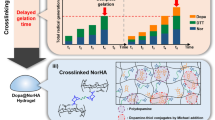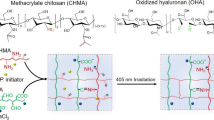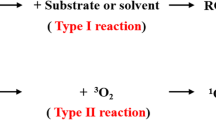Abstract
Mussel-inspired polymers have emerged as attractive candidates for the synthesis of injectable hydrogels with tissue-adhesive properties. In these systems, polymer crosslinking occurs via the oxidative coupling of catechol groups grafted on the polymer backbone, performed in the presence of an enzyme or a chemical oxidant. Here, we show that catechol-modified hyaluronic acid (HA-CA) can self-crosslink in physiological conditions without any requirement of oxidizing reagents. A careful rheological analysis of gelation of HA-CA solutions indicated that both the degree of substitution and the molar mass of HA-CA are key parameters controlling the gelation kinetics. Interestingly, the gelation time could be dramatically lowered by photo-oxidation of catechol using visible light in the presence of eosin Y as a photosensitizer. This strategy can be advantageously used to manage viscosity and gelation kinetics during injection, which paves the way for various biomedical applications of HA-CA including wound closure and healing as well as drug delivery.






Similar content being viewed by others
References
Hoffman AS (2013) Stimuli-responsive polymers: biomedical applications and challenges for clinical translation. Adv Drug Deliv Rev 65:10–16
Kirschner CM, Anseth KS (2013) Hydrogels in healthcare: from static to dynamic material microenvironments. Acta Mater 61:931–944
Li Y, Rodrigues J, Tomas H (2012) Injectable and biodegradable hydrogels: gelation, biodegradation and biomedical applications. Chem Soc Rev 41:2193–2221
Peppas NA, Hilt JZ, Khademhosseini A, Langer R (2006) Hydrogels in biology and medicine: from molecular principles to bionanotechnology. Adv Mater 18:1345–1360
Bae KH, Wang L-S, Kurisawa M (2013) Injectable biodegradable hydrogels: progress and challenges. J Mater Chem B Mater Biol Med 1:5371–5388
Hunt JA, Chen R, van Veen T, Bryan N (2014) Hydrogels for tissue engineering and regenerative medicine. J Mater Chem B Mater Biol Med 2:5319–5338
Huynh CT, Nguyen MK, Lee DS (2011) Injectable block copolymer hydrogels: achievements and future challenges for biomedical applications. Macromolecules 44:6629–6636
Joo MK, Park MH, Choi BG, Jeong B (2009) Reverse thermogelling biodegradable polymer aqueous solutions. J Mater Chem 19:5891–5905
Kim DY, Kwon DY, Kwon JS, Kim JH, Min BH, Kim MS (2015) Stimuli-responsive injectable in situ-forming hydrogels for regenerative medicines. Polym Rev 55:407–452
Teixeira LSM, Feijen J, van Blitterswijk CA, Dijkstra PJ, Karperien M (2012) Enzyme-catalyzed crosslinkable hydrogels: emerging strategies for tissue engineering. Biomaterials 33:1281–1290
Nguyen MK, Lee DS (2010) Injectable biodegradable hydrogels. Macromol Biosci 10:563–579
Patenaude M, Smeets NMB, Hoare T (2014) Designing injectable, covalently cross-linked hydrogels for biomedical applications. Macromol Rapid Commun 35:598–617
Fu S, Ni P, Wang B, Chu B, Zheng L, Luo F, Luo J, Qian Z (2012) Injectable and thermo-sensitive PEG-PCL-PEG copolymer/collagen/n-HA hydrogel composite for guided bone regeneration. Biomaterials 33:4801–4809
Hou Q, De Bank PA, Shakesheff KM (2004) Injectable scaffolds for tissue regeneration. J Mater Chem 14:1915–1923
Yang J-A, Yeom J, Hwang BW, Hoffman AS, Hahn SK (2014) In situ-forming injectable hydrogels for regenerative medicine. Prog Polym Sci 39:1973–1986
Lee Y, Chung HJ, Yeo S, Ahn C-H, Lee H, Messersmith PB, Park TG (2010) Thermo-sensitive, injectable, and tissue adhesive sol-gel transition hyaluronic acid/pluronic composite hydrogels prepared from bio-inspired catechol-thiol reaction. Soft Matter 6:977–983
Lee SH, Lee Y, Lee S-W, Ji H-Y, Lee J-H, Lee DS, Park TG (2011) Enzyme-mediated cross-linking of pluronic copolymer micelles for injectable and in situ forming hydrogels. Acta Biomater 7:1468–1476
Deming TJ (1999) Mussel byssus and biomolecular materials. Curr Opin Chem Biol 3(1):100–105
Lee BP, Messersmith PB, Israelachvili JN, Waite JH (2011) Mussel-inspired adhesives and coatings. Annu Rev Mater Res 41:99–132
Yu M, Hwang J, Deming TJ (1999) Role of L-3,4-dihydroxyphenylalanine in mussel adhesive proteins. J Am Chem Soc 121:5825–5826
Lee BP, Dalsin JL, Messersmith PB (2002) Synthesis and gelation of DOPA-modified poly(ethylene glycol) hydrogels. Biomacromolecules 3:1038–1047
Shin J, Lee JS, Lee C, Park H-J, Yang K, Jin Y, Ryu JH, Hong KS, Moon S-H, Chung H-M, Yang HS, Um SH, Oh J-W, Kim D-I, Lee H, Cho S-W (2015) Tissue adhesive catechol-modified hyaluronic acid hydrogel for effective, minimally invasive cell therapy. Adv Funct Mater 25:3814–3824
Kim K, Ryu JH, Lee DY, Lee H (2013) Bio-inspired catechol conjugation converts water-insoluble chitosan into a highly water-soluble, adhesive chitosan derivative for hydrogels and LbL assembly. Biomater Sci 1:783–790
Lee C, Shin J, Lee JS, Byun E, Ryu JH, Um SH, Kim DI, Lee H, Cho SW (2013) Bioinspired, calcium-free alginate hydrogels with tunable physical and mechanical properties and improved biocompatibility. Biomacromolecules 14:2004–2013
Hong S, Yang K, Kang B, Lee C, Song IT, Byun E, Park KI, Cho SW, Lee H (2013) Hyaluronic acid catechol: a biopolymer exhibiting a pH-dependent adhesive or cohesive property for human neural stem cell engineering. Adv Funct Mater 23:1774–1780
Destaing O, Planus E, Bouvard D, Oddou C, Badowski C, Bossy V, Raducanu A, Fourcade B, Albiges-Rizo C, Block MR (2010) β1A integrin is a master regulator of invadosome organization and function. Mol Biol Cell 21:4108–4119
Chung H, Grubbs RH (2012) Rapidly cross-linkable DOPA containing terpolymer adhesives and PEG-based cross-linkers for biomedical applications. Macromolecules 45:9666–9673
Faessler R, Pfaff M, Murphy J, Noegel AA, Johansson S, Timpl R, Albrecht R (1995) Lack of β1 integrin gene in embryonic stem cells affects morphology, adhesion, and migrations but not integration into the inner cell mass of blastocysts. J Cell Biol 128:979–988
Mansukhani A, Bellosta P, Sahni M, Basilico C (2000) Signaling by fibroblast growth factors (FGF) and fibroblast growth factor receptor 2 (FGFR2)–activating mutations blocks mineralization and induces apoptosis in osteoblasts. J Cell Biol 149:1297–1308
Bouvard D, Aszodi A, Kostka G, Block MR, Albiges-Rizo C, Fassler R (2007) Defective osteoblast function in ICAP-1-deficient mice. Development 134:2615–2625
Yang J, Stuart MAC, Kamperman M (2014) Jack of all trades: versatile catechol crosslinking mechanisms. Chem Soc Rev 43:8271–8298
Kalyanaraman B, Felix CC, Sealy RC (1985) Semiquinone anion radicals of catechol (amine)s, catechol estrogens, and their metal ion complexes. Environ Health Perspect 64:185–198
Burzio LA, Waite JH (2000) Cross-linking in adhesive quinoproteins: studies with model decapeptides. Biochemistry 39:11147–11153
Loebel C, Broguiere N, Alini M, Zenobi-Wong M, Eglin D (2015) Microfabrication of photo-cross-linked hyaluronan hydrogels by single- and two-photon tyramine oxidation. Biomacromolecules 16:2624–2630
Bonino CA, Samorezov JE, Jeon O, Alsberg E, Khan SA (2011) Real-time in situ rheology of alginate hydrogel photocrosslinking. Soft Matter 7:11510–11517
Kavanagh GM, Ross-Murphy SB (1998) Rheological characterization of polymer gels. Prog Polym Sci 23:533–562
Andersen SO, Jacobsen JP, Bojesen G, Roepstorff P (1992) Phenoloxidase catalyzed coupling of catechols. Identification of novel coupling products. Biochim Biophys Acta 1118:134–138
Barreto WJ, Ponzoni S, Sassi P (1999) A Raman and UV-vis study of catecholamines oxidized with Mn(III). Spectrochim Acta Part A Mol Biomol Spectrosc 55A:65–72
Linert W, Herlinger E, Jameson RF, Kienzl E, Jellinger K, Youdim MBH (1996) Dopamine, 6-hydroxydopamine, iron, and dioxygen—their mutual interactions and possible implication in the development of Parkinson’s disease. Biochim Biophys Acta 1316:160–168
Zafar KS, Siegel D, Ross D (2006) A potential role for cyclized quinones derived from dopamine, DOPA, and 3,4-dihydroxyphenylacetic acid in proteasomal inhibition. Mol Pharmacol 70:1079–1086
Turturro MV, Sokic S, Larson JC, Papavasiliou G (2013) Effective tuning of ligand incorporation and mechanical properties in visible light photopolymerized poly(ethylene glycol) diacrylate hydrogels dictates cell adhesion and proliferation. Biomed Mater 8:025001–025012 (Bristol, United Kingdom)
Kang X, Yu Y, Bao Y, Cai W, Cui S (2015) Real time quantification of the chemical cross-link density of a hydrogel by in situ UV-vis spectroscopy. Polym Chem 6:4252–4257
Zwicker EF, Grossweiner LI (1963) Transient measurements of photochemical processes in dyes. II. The mechanism of the photosensitized oxidation of aqueous phenol by eosin. J Phys Chem 67:549–555
Bahney CS, Lujan TJ, Hsu CW, Bottlang M, West JL, Johnstone B (2011) Visible light photoinitiation of mesenchymal stem cell-laden bioresponsive hydrogels. Eur Cells Mater 22:43–55
Waite JH, Qin X (2001) Polyphosphoprotein from the adhesive pads of Mytilus edulis. Biochemistry 40:2887–2893
Waite JH, Tanzer ML (1980) The bioadhesive of Mytilus byssus: a protein containing L-dopa. Biochem Biophys Res Commun 96:1554–1561
Ryu JH, Lee Y, Do MJ, Jo SD, Kim JS, Kim BS, Im GI, Park TG, Lee H (2014) Chitosan-g-hematin: enzyme-mimicking polymeric catalyst for adhesive hydrogels. Acta Biomater 10:224–233
Zhou J, Defante AP, Lin F, Xu Y, Yu J, Gao Y, Childers E, Dhinojwala A, Becker ML (2015) Adhesion properties of catechol-based biodegradable amino acid-based poly(ester urea) copolymers inspired from mussel proteins. Biomacromolecules 16:266–274
Acknowledgements
This work was financially supported by a Grant-in-Aid for JSPS Fellows KAKENHI (Grant No. 265612). We are grateful to Prof. M. R. Block for the cell viability testing of the HA-CA hydrogels. We thank Eric Bayma-Pecit for his technical help in the rheological experiments.
Author information
Authors and Affiliations
Corresponding author
Electronic supplementary material
Below is the link to the electronic supplementary material.
Rights and permissions
About this article
Cite this article
Sato, T., Aoyagi, T., Ebara, M. et al. Catechol-modified hyaluronic acid: in situ-forming hydrogels by auto-oxidation of catechol or photo-oxidation using visible light. Polym. Bull. 74, 4069–4085 (2017). https://doi.org/10.1007/s00289-017-1937-y
Received:
Revised:
Accepted:
Published:
Issue Date:
DOI: https://doi.org/10.1007/s00289-017-1937-y




